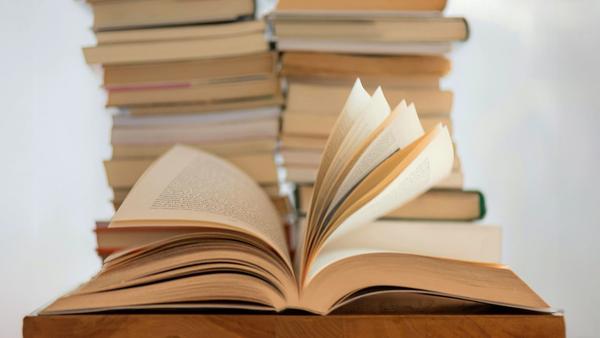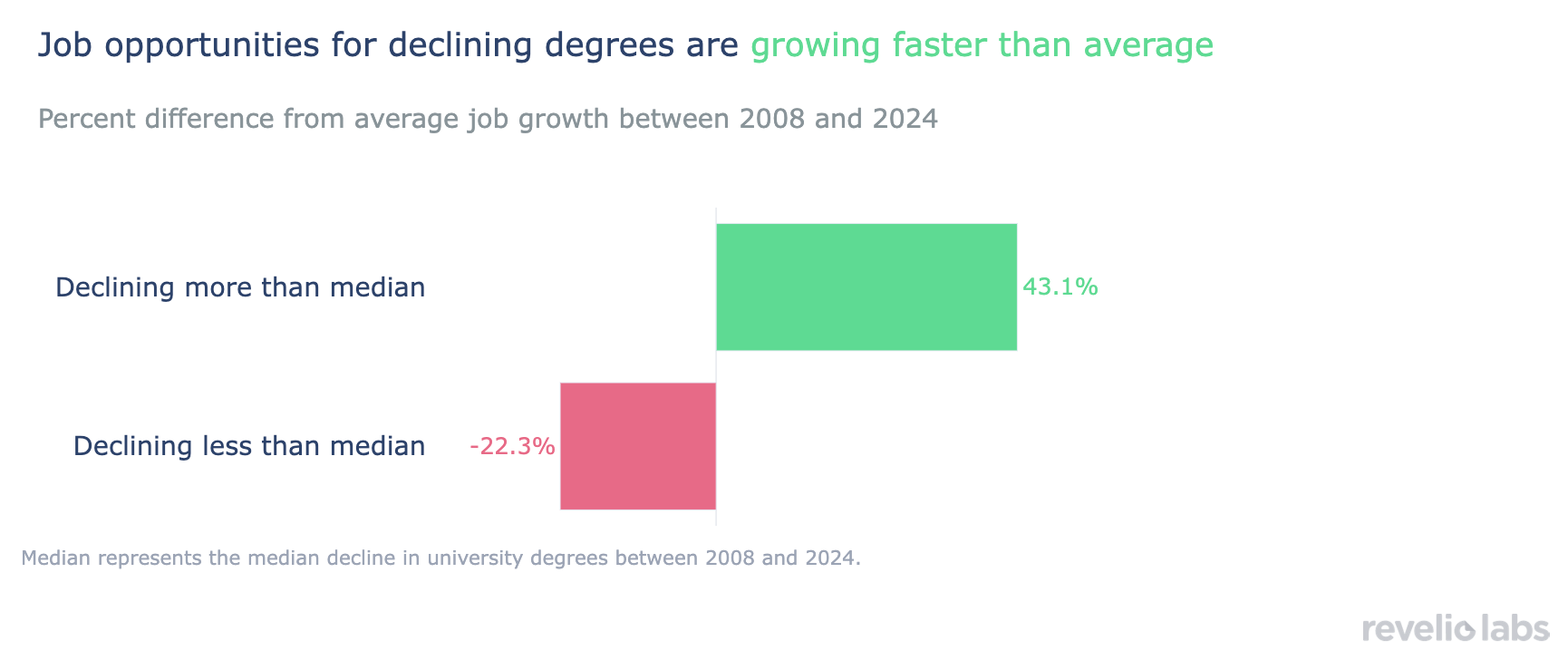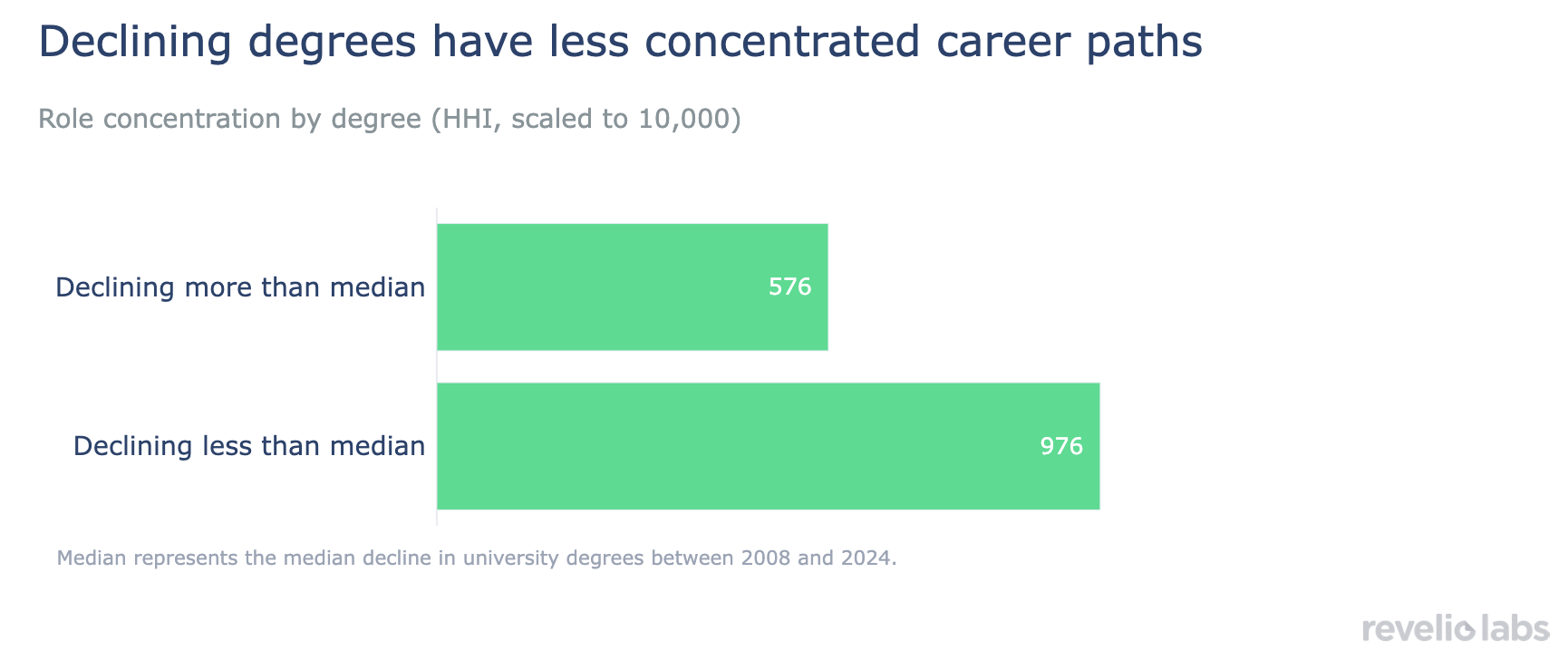Specialized degrees lead to careers, humanities degrees offer versatility
What degrees are falling out of favor with students?

University majors such as History, English, and Journalism have experienced the largest declines in graduates since 2008.
Majors that declined more than the median offer starting salaries 8.5% below the national average. However, growth in job opportunities for these majors has been greater than average.
These declining majors lead to less focused career paths, with graduates spreading across a broader range of roles, while less-declining majors are nearly twice as concentrated, channeling graduates into a smaller, more specialized set of careers.
As new undergraduate students gear up for the upcoming school year, amid a rise in entry-level unemployment bolstered by AI and federal budget cuts that threaten smaller departments, they face the increasingly difficult task of choosing a major and subsequent career path. While a college degree once offered a straightforward path to stable employment, students today must weigh which degrees offer the best returns and strongest career opportunities after graduation.
This week, we use Revelio Labs’ workforce intelligence data to examine which university majors or degree programs have experienced the greatest fall in the number of graduates since 2008 and explore the possible reasons behind these trends. These shifts offer insight into how student preferences and labor market demands have evolved over the past decade and how they shape the career prospects of recent graduates.
When comparing the share of graduates in each major between 2008 and 2024, we find that History, among other liberal arts degrees, has seen the largest decline. The top ten declining degrees, which accounted for 21% of all graduates in 2008, represented just 10% in 2024.


To understand why students have shifted away from certain majors, we split graduates into two groups: those from majors that declined more than the median in the number of graduates compared to those from less-declining majors. As shown in the chart below, graduates from the group with more severely declining degrees earn 8.5% (or $5.8k) less in starting salaries than those from the less-declining group, suggesting that lower earnings may be a key factor behind the decline in these programs.


Despite lower salaries, the opportunities for degrees in the more-declining group have grown faster than average since 2008. We look at job opportunities in the 20 most common roles that graduates from a major typically take. Job opportunities for the more-declining degrees have grown 43% more than the national average, while those for less-declining degrees have fallen by 22%. This points to a more competitive job market for higher-paying degrees and a growing—but less lucrative—market for the more-declining degree holders. While job growth for more-declining degrees is stronger, lower pay may be deterring students from pursuing these paths as university becomes more expensive and students look to maximize their earnings post graduation.


While declining degrees can still lead to careers in growing fields, they may be less appealing to students if they lack a clear career path. By examining the concentration of roles that students take after graduation using the Herfindahl-Hirschman Index (HHI), we find that the more-declining degrees show lower career concentration (lower HHI), with graduates dispersing across a wider range of roles. Less-declining degrees, in contrast, are almost twice as concentrated (higher HHI) and tend to channel graduates into a smaller, more defined set of careers. These majors are almost more vocational in nature, where students learn a particular set of skills only applicable to a certain set of occupations, such as nursing or data science. In a labor market that increasingly rewards specialization over general knowledge, this clarity may give the less-declining degrees a competitive edge in attracting students.


As a case study, we compare the degree that has declined in popularity the most since 2008—History—with the degree that has grown the most in the same period—Data Analytics. When we look at the share of graduates working in the top five most common roles for each degree, we find that more than 40% of Data Analytics graduates work in their top five roles, while less than 15% of History graduates do the same. With its emphasis on specialized knowledge in data, programming, and software, Data Analytics enables graduates to quickly identify and target specific roles after graduation. History graduates, by contrast, have a more varied set of top roles requiring different skillsets typically acquired through on-the-job experience.


It is clear that multiple factors influence students when selecting their majors. By analyzing which degrees have declined the most since 2008, we see a shift in how students view the role of education in their careers and what they prioritize when choosing a major. Amid the rise of AI and broader labor market shifts, students are increasingly opting for specialized expertise rather than a general education to streamline their careers after graduation. Additionally, the lower salaries linked to declining degrees—likely due to their lower specialization—act as a deterrent, despite job opportunities in these fields growing. Still, prospective students should weigh how their major supports both immediate career goals and long-term relevance in an AI-driven labor market. As AI takes on more specialized tasks, employers will prize graduates with diverse skill sets and the ability to reason. Our advice: Choose a major that aligns with your interests but also positions you well for the future.


